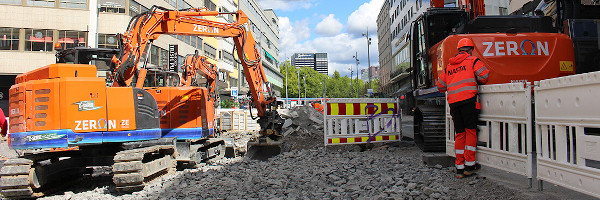E-Worksite: Difference between revisions
No edit summary |
No edit summary |
||
| (9 intermediate revisions by the same user not shown) | |||
| Line 1: | Line 1: | ||
{{Chapter | {{Chapter | ||
| | |image=constructionelectrificationChapter.jpg | ||
| | |poc=Wilfred Pinfold | ||
| authors = Wilfred Pinfold | |authors=Wilfred Pinfold | ||
| | |blueprint=Buildings | ||
| | |sectors=Buildings | ||
| document = 2020-SBSC-blueprint.pdf | |summary=Construction sites are the source of material waste, visible dust, noise, and vibration. Construction and demolition sites also produce less obvious pollutants which are of serious concern for human health, namely NO2 and particulate matter. Combined with increasing urbanization trends and a fast-growing global population, it goes without saying that construction is here to stay. This chapter explores technologies that electrify construction equipment. | ||
| chapter = 1010 | |document=2020-SBSC-blueprint.pdf | ||
|chapter=1010 | |||
}} | }} | ||
__NOTOC__ | |||
Many of today’s construction equipment trends are the result of '''advancements in digital technology''', some of which reduce skilled labor requirements: | Many of today’s construction equipment trends are the result of '''advancements in digital technology''', some of which reduce skilled labor requirements: | ||
*'''Autonomous heavy equipment''' is now used to excavate, grade and perform a growing amount of work on construction sites. | *'''Autonomous heavy equipment''' is now used to excavate, grade and perform a growing amount of work on construction sites. | ||
| Line 25: | Line 26: | ||
Historically, tower cranes were hydraulically powered, but most manufacturers made the switch to electric in the 1970s. This gave them more advanced mechanics, variable speeds and better hoisting winches while reducing the required power and making them more energy efficient. | Historically, tower cranes were hydraulically powered, but most manufacturers made the switch to electric in the 1970s. This gave them more advanced mechanics, variable speeds and better hoisting winches while reducing the required power and making them more energy efficient. | ||
=Compact Excavator= | =Compact Excavator= | ||
There are now a wide range of excavators from manufacturers including Volvo, Bobcat, CASE, JBC and Wacker Neuson | |||
Wacker Neuson | |||
Latest revision as of 23:39, January 19, 2023
- Authors
Construction sites are the source of material waste, visible dust, noise, and vibration. Construction and demolition sites also produce less obvious pollutants which are of serious concern for human health, namely NO2 and particulate matter. Combined with increasing urbanization trends and a fast-growing global population, it goes without saying that construction is here to stay. This chapter explores technologies that electrify construction equipment.
Many of today’s construction equipment trends are the result of advancements in digital technology, some of which reduce skilled labor requirements:
- Autonomous heavy equipment is now used to excavate, grade and perform a growing amount of work on construction sites.
- Autonomous drones and rovers use cameras and LiDAR to perform scans of a job site; then use artificial intelligence to determine daily progress against the schedule and to identify any errors.
- Specialized robots under human supervision can perform repetitive construction tasks such as bricklaying, painting, loading and tying rebar, with the ability to work nonstop.
- The Internet of Things (IoT) enables a digitally integrated construction process and job site. It includes smart construction machines with sensors that collect and transmit data to each other and with their home base.
- Predictive telematics and analytics send machine diagnostics alerts and other vital information to fleet managers and equipment owners for off-site management.
Growing demand for machine electrification in construction and other types of equipment continues to drive global development of new battery technologies.
- OEMs are converting equipment from lead-acid to lithium batteries, which are 20%-30% more efficient.
- Battery chargers are moving toward integration into the equipment they power.
- One leading manufacturer recently introduced the first fully electric backhoe loader at CONEXPO 2020. This machine is powered by a 480V, 90kWh lithium-ion battery pack, capable of working a typical 8-hour day on a single charge.
The global market for compact construction equipment is forecast to grow from more than $10 billion in 2017 to more than $15 billion in 2025. The electrification of these machines is easier than on large construction equipment and is a growing trend. One global OEM has announced that it will stop producing its diesel-powered versions, converting to an all-electric product line. The company is promoting them as small, quiet, zero-emissions machines for use in cities and densely populated areas.
Cranes
Historically, tower cranes were hydraulically powered, but most manufacturers made the switch to electric in the 1970s. This gave them more advanced mechanics, variable speeds and better hoisting winches while reducing the required power and making them more energy efficient.
Compact Excavator
There are now a wide range of excavators from manufacturers including Volvo, Bobcat, CASE, JBC and Wacker Neuson

